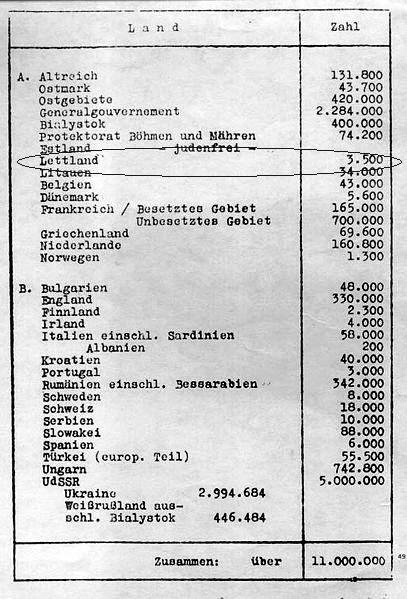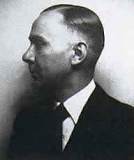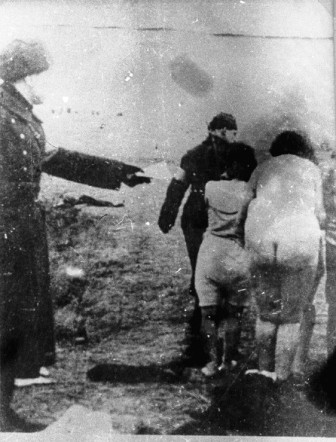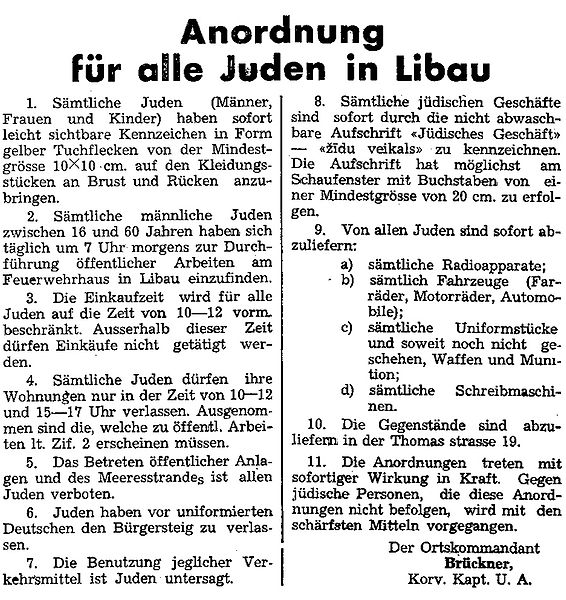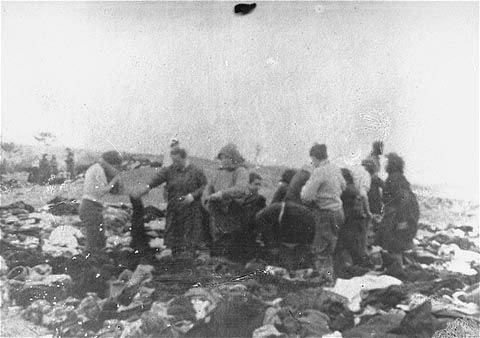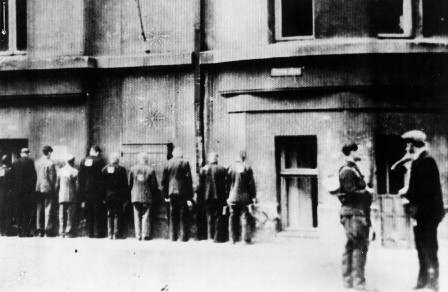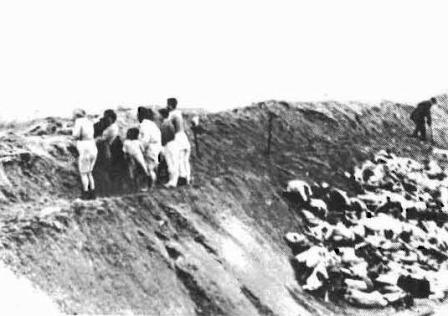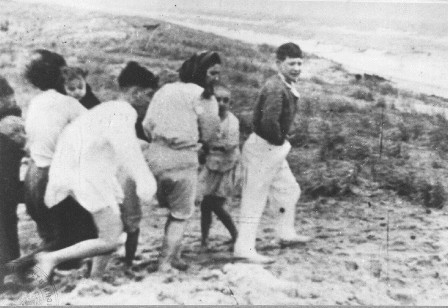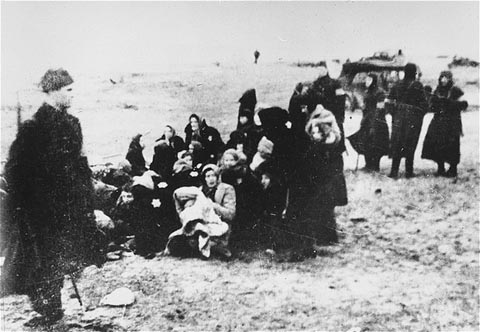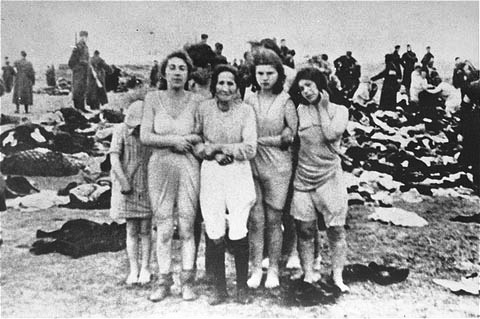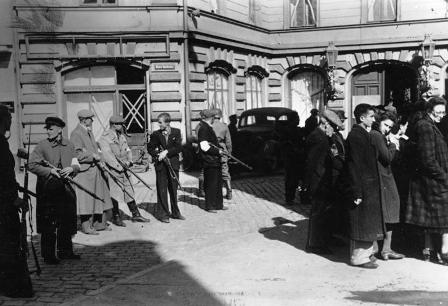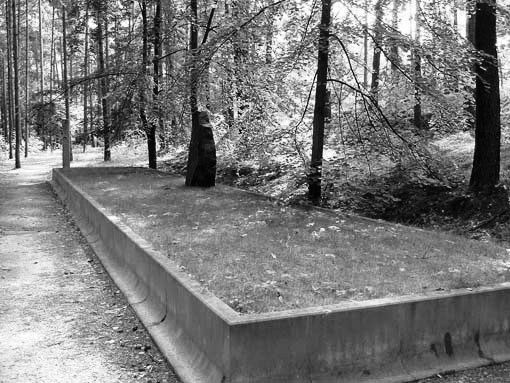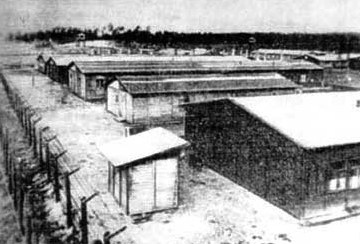Einsatzgruppen A Mass murder of Jews in Latvia Jews have occupied the region of the Baltic countries since the fourteenth century. The primary concentration of the Jewish population was in the cities, Daugavpils, Vilnius and Riga in particular. The Latvian census taken in 1935 identified 93,479 Jews living in throughout the country, of these, it is estimated that about 70,000 perished in the Holocaust, the vast majority at the hands of Einsatzgruppen death squads in December 1941. The totality and speed with which the mass murder of Jews in Latvia was achieved meant that most families were completely destroyed with no one left to mourn or even inquire about the dead. On June 22, 1941 the Germans began Operation Barbarossa, the invasion of Russia. Because of the Nazi-Soviet Pact of 1939, the Baltic countries were considered a part of Russia. Immediately following the invasion, Himmler was appointed to take measures to strengthen German ethnicity in the occupied territories and to create lebensraum, or living space for German citizens. To this end, Himmler created special task forces within the SS, the Einsatzgruppen, and placed them under the command of Reinhard Heydrich. On September, 21, 1939, Heydrich instructed those under his command to observe a distinction between a final solution which would take some time and intermediary steps necessary for reaching this end, which can be applied more or less at once. (Heydrich Directive) 21.September.1939
Berlin
To Chiefs of all Einsatzgruppen of the Security Police Subject: Jewish Question in Occupied Territory
I refer to the conference held in Berlin today, and again point out that the planned total measures (i.e., the final aim) are to be kept
strictly secret.
Distinction must be made between:
1. the final aim (which will require extended periods of time)
and
2. the stages leading to the fulfillment of this final aim (which will be carried out in short periods).
It is obvious that the tasks ahead cannot be laid down from here in full detail. The instructions and directives below must serve also for
the purpose of urging chiefs of the Einsatzgruppen to give practical consideration to [the problems involved.]
For the time being, the first prerequisite for the final aim is the concentration of the Jews from the countryside into the larger cities. |
In the Baltic region, the Holocaust was organized and supervised by a special Operational Unit of the Nazi Security Service Sicherheitsdienst commanded by Brigadeführer Walter Stahlecker. This unit arrived with the advance troops of the occupying army. From November 1941 onward, the command was assumed by SS and Police General Friedrich Jeckeln, the Supreme Commander of the SS and Police in Northern Russia and Ostland. Jews in Latvia became Nazi victims within days of Nazi occupation. As in Lithuania, Latvian Jews fell into the hands of the German Einsatzgruppe A, aided by a group of Latvian citizens known as the Arajs Kommando who willingly assisted in the mass genocide of Latvian Jews. The killing of the Jews occurred in two phases. The first phase was between July and October 1941, where the rural population was liquidated. The second phase was the extermination of the Jews in the cities from November to December 1941. Of the approximately 66,000 Jews in Latvia at the time of the Nazi invasion, there were as many as 59,000 that were killed in 1941. The remaining Jews were sent to ghettos to be used as slave labor. Ultimately, these Jews were transported to Germany in 1944. Of those, most perished there. The largest action taken against Latvian Jews occurred on November 30 and December 8, 1941. 25,000 Jews from Riga were murdered in an action that came to known as Rumbula, named for the railway station nearby. The Shootings begin: The actions began on the night of June 23 to June 24, 1941, when in the Grobina cemetery SD murderers killed six local Jews, including the town chemist. In the days to follows 35 Jews were exterminated in Durbe, Priekule and Asite. On June 29 the Nazi invaders started forming the first Latvian SD auxiliary unit in Jelgava. Martinš Vagulans, member of the Perkonkrusts organization, was chosen to head it. Some 300 men in the unit took part in the extermination of about 2000 Jews in Jelgava and other places in Zemgale. The killing was supervised by the officers of the German SD Rudolf Batz and Alfred Becu, who involved the SS people of the Einsatzgruppe in the action. They looted and destroyed many of the Jewish homes and burned the Jelgava Synagogue to the ground. After the invasion of Riga Walter Stahlecker, assisted by the members of Perkonkrusts and other local collaborationists, organized the pogrom of Jews in the capital of Latvia. Viktors Arajs, aged 31 at the time, former member of Perkonkrusts and a member of a student fraternity, was appointed direct executor of the action. Daugavpils On June 28, 1941, two days after the fall of Daugavpils, the Nazis rounded up Jews in a synagogue, and then took them out to a large ditch and shot them. Other Jews were randomly murdered simply walking down the street. On Sunday, June 29, 1941, the German army began rounding up Jewish men in Daugavpils to subject them to terror, humiliation and imprisonment under brutal and overcrowded conditions. At gun point the Germans made them shout "Heil Hitler", and sing pro-Nazi songs. One survivor Sema Shpungin said:
They were seizing Jews in the streets of Dvinsk and taking them to the prison where they were severely tormented. They were forced to lie down on the ground and jump up again; those who could not do it fast enough were shot. Paula Frankel-Zaltzman described her experience:
One of the murderers went up to my father and shouted to his face: 'How many houses did you burn?' and gave him a blow with his pistol. the two Germans entered and started to shout that we are communists and that's why we're hiding - and they wanted to arrest us.
The Germans accused them of setting fire to Daugavpils. According to Stahlecker's official report:
In Latvia as well the Jews participated in acts of sabotage and arson after the invasion of the German Armed Forces. In Duenaburg so many fires were lighted by the Jews that a large part of the town was lost. The electric power station burnt down to a mere shell. The streets which were mainly inhabited by Jews remained unscathed.
Jews in general and Lithuanian refugees in particular were accused of being communists. On July 8, 1941, a newspaper in Daugavspils (Daugavpils Latviešu Avize), published an editorial consistent with the German efforts to blame the Jews for communist atrocities.
| The time has come to end all service to the Jews, to end every selling of oneself to the Jews! ... One must remember that it was the Jews who greeted the Red Army in July 1940 and enslaved, tortured, and killed Latvians during communist rule. |
As time went on, increased numbers of Latvian auxiliary police guarded the prison where the Jewish men were held. By July 8, 1941, the work had become so hard that the Jews were literally being worked to death. One assignment included rolling huge blocks of stone to the top of a hill, another including carrying heavy timbers several kilometers. German guards struck prisoners with whips at will. Later, the expression arose among the widows of the men who were rounded up and killed on June 29 about their husbands was "'he was taken way to prison that First Sunday.'" By July 7, 1941, the Latvia police had arrested about 1,250 people, including 1,125 Jews, and were holding them in the main prison in Daugavpils. The Railroad Park massacre
One survivor named Iwens, described the scene: On July 8, 1941, the Germans forced a detail of Jews to dig ditches in the Railroad Park. The next day, the Germans began shooting Jews and pushing the bodies into the ditches. The sound of gunshots, occurring at regular intervals, could be heard in the city. Among the murdered was one man who tried to explain to a guard that he was a decorated veteran of the German army from the First World War. While the guards in this operation were Latvian, the supervisors were entirely German. One German officer hummed the Beer Barrel Polka in between shooting people in the back of the head. The Germans filled all the trenches dug on July 8 with the bodies of the persons murdered on July 9, but there were still a lot of people left alive whom they had intended to kill. At the end of the killings on July 8, the survivors were put to work digging new graves and tamping down the earth over the bodies in the previous trenches. The next day, July 10, 1941, the killings resumed. Another survivor Haim Kuritzky, about what occurred at the burial pits: At a long ditch ahead of them were four Latvian auxiliaries loading their rifles. A German officer yelled at the prisoners, "Four of you, march ahead." When the men reached the ditch, the German yelled "fire!" Each of the Latvians fired at one man -- one bullet in the head at close range -- and the four fell in the ditch. "The next four." They were shot too.
But then, the remaining prisoners were given spades and ordered to cover the ditches with dirt -- there was no more room. The ditches were full of dying people and blood. They struggled spasmodically like fish out of water ... heads hanging back ... a wet, slippery, moving mass ... All of the killing was being filmed by German soldiers.
The Liepāja Actions The first mass killing of Jews in Liepāja took place on July 3 and 4, when about 400 people were shot to death, followed by the shooting of another 300 Jews on July 8. The German group of SD and policemen did the shooting, while the members of Latvian Selbstschutz convoyed victims to the killing site. Shortly after these killings occured the destroying of the large choral synagogue of Liepāja began. On July 13, the rolls of the Scripture were spread on the Ugunsdzēsēju Square, and the Jews were forced to march across their sacred reliquaries much to the amusement of the perpetrators and their Latvian accomplices. The remaining Jews were taken to Skede, north of Liepaja, to the dunes overlooking the Baltic Sea, the site of a former military training grounds. A long ditch had been dug just before the dunes. The Jews were forced to strip off their clothes except for their underwear. Near the ditch they then were made to take off their remaining clothes and assemble in groups of ten. They were executed by members of a Latvian SD guard platoon, units of the 21st Latvian police battalion, and members of the SD under the command of the local SS and Police Leader Fritz Dietrich. On the 15-17 of December, 2,700-2,800 Jews were massacred, most of them women and children. Two SD men, one of them was identified as Oberscharführer Carl Strott are reported as using a whip to make the Jewish women pose for pictures. According to the SIPO report on the execution, the Germans filmed the execution to show that the executions were carried out by locals. Mass shooting actions also tool place at Ventspils and Rēzekne On July 16-July 18, 300 people were shot dead in the Kaziņu Forest. In July-August the remaining 700 Jews of the town were shot dead, while the Jews of the region were killed in the autumn. The shooting was carried out by German, Latvian and Estonian SD men who had arrived by ship. In Rēzekne approximately 2500 people were exterminated. Shortly after signs were posted on the Kuldīga-Ventspils highway, which said that Ventspils and Rēzekne were Judenfrei, or "Jew Free." Riga and the Rumbula shootings In mid- August a decree was enacted ordering all Jews into the ghetto, which had been set up in the Moscow quarter, a suburb north of Riga populated by Jews and poor Russians. By the time the ghetto was sealed off 29,602 Jews were concentrated there, made up of 15,738 women, 8,212 men and 5,652 children On the 30 November 1941 the most elaborate measures were prepared in Riga. The ghetto’s were cordoned, the Jewish working commando’s were marched out under guard, while rows of modern, blue Riga motor-buses were drawn up outside the ghetto gates. Miles outside the ghetto in the forest, not far from the railway at Rumbula, execution pits had been dug by Russian prisoners of war. A daily report issued while the massacre was in progress, declared that Jeckeln was engaged in a “shooting action,” and that on 30 November 4,000 Jews from the Riga ghetto and an entire transport of Jews from the Reich had been dealt with.
This was the notorious “Bloody Sunday,” but the second Riga action on 8 December on 8 December was almost on the same scale. One witness while gathering firewood for the Wehrmacht saw the preparations in the forest, two lorry-loads of German police troops and a long row of machine guns.
Mass shooting outside Riga
This action was curtailed. At 12 o’clock, when a column of the condemned Jews were marching out of the ghetto, the police NCO pulled out his watch and remarked: “You are in luck. It is one minute after time – the action is over.”
During this action the entire population of the “large ghetto” was killed, including most of the members of the Council of Elders, the historian Simon Dubnow and Rabbi Menahem Mendel Zak, the Chief Rabbi of Riga.
The actions at Dünamünde In March, 1942, the Nazi authorities in Riga decided the German ghetto was getting too crowded, and organized a massacre which has come to be called the "Dünamünde Action". The Nazis informed the Judenrat that the people, who were mostly unable to work, being either elderly, infirm, or mothers with young children, would go to a supposed town called Dünamünde to work at fish processing. This was a ruse put together by Obersturmbannführer Gerhard Maywald. There was no longer a town called Dünamünde, and there had not been one for several decades. The ruse succeeded. Many people were anxious to go, and even though the Germans had only called for 1,500 to be selected, on Sunday, March 15, 1941, about 1,900 Jews assembled in the streets of the ghetto, including as with the Rumbula massacre, many parents with small children, to be "resettled". There was of no resettlement of any kind. Instead the people were taken by motor transport to Bikernieki forest on the north side of Riga, where they were shot and buried in common unmarked graves.
Jungfernhof concentration camp actions
On March 26, 1941, a similar ruse was perpetrated at against older German Jews. The camp commander, Rudolf Seck, refused young people of working age permission to go with their parents. 1,840 people were "resettled" from Jungfernhof that day, again to Bikernieki forest where they were shot as had been the 1,900 German Jews from the ghetto 11 days earlier.
A method the Germans called "Sardine Packing" was used to bury the corpses of the murdered Jews. German efficiency would not allow for any haphazard arrangement of the corpses, as this was an inefficient use of burial space. The killers forced the victims to lie face down at the bottom of the trench or on top of the bodies of the people who had been shot before them. In order to conserve ammunition the victims were not sprayed with bullets, each person was shot just once, in the back of the head. Anyone not killed outright was simply buried alive when the pit was covered up. The end of the actions By the beginning of 1943 only about 5,000 Jews remained in Latvia. They were concentrated in the Riga, Dvinsk, and Liepaja ghettos and in a few labor camps. Mid way through the year the Riga Ghetto was closed and those Jews still alive and able to work were transferred to nearby smaller camps, located at Mežaparks/Kaiserwald and Dundaga. In 1944 the Soviet army reentered Latvia, which again became a Soviet republic. Only a few hundred Jews remained in Latvia. About 1,000 Latvian Jews returned to Latvia from the Nazi concentration camps; several thousand others who had escaped to the Soviet Union during the war also survived. However, the horrendous losses sustained during the Nazi Holocaust utterly devastated Latvian Jewry.
Sources: The Murder of the Jews in Latvia, 1941-1945 By Bernhard Press, Laimdota Mazzarins Tainy rizhskogo podpol´ia: bor´ba rabochikh Rigi v gody gitlerovskoi okkupatsii, 1941-1944. By Ianis Dzintars Anders, Edward and Juris Dubrovskis. Jews in Liepaja, Latvia 1941–45: A Memorial Book. Burlingame, CA., 2001 The Hidden and Forbidden History of Latvia under the Soviet and Nazi Occupations 1940–1991. Symposium of the Commission of the Historians of Latvia 14. Rīga: Institute of the History of Latvia, 2005.
M. Bobe, Perakim be-Toledot Yahadut Latvia (1965)
M. Kaufmann, Die Vernichtung der Juden Lettlands (1947)
Jewish Central Information Office, London, From Germany to the Riga Ghetto (1945
Andrew Ezergailis (1996). The Holocaust in Latvia, 1941-1944. Historical Institute of Latvia, Riga ; United States Holocaust Memorial Museum Yad Vashem
. |
